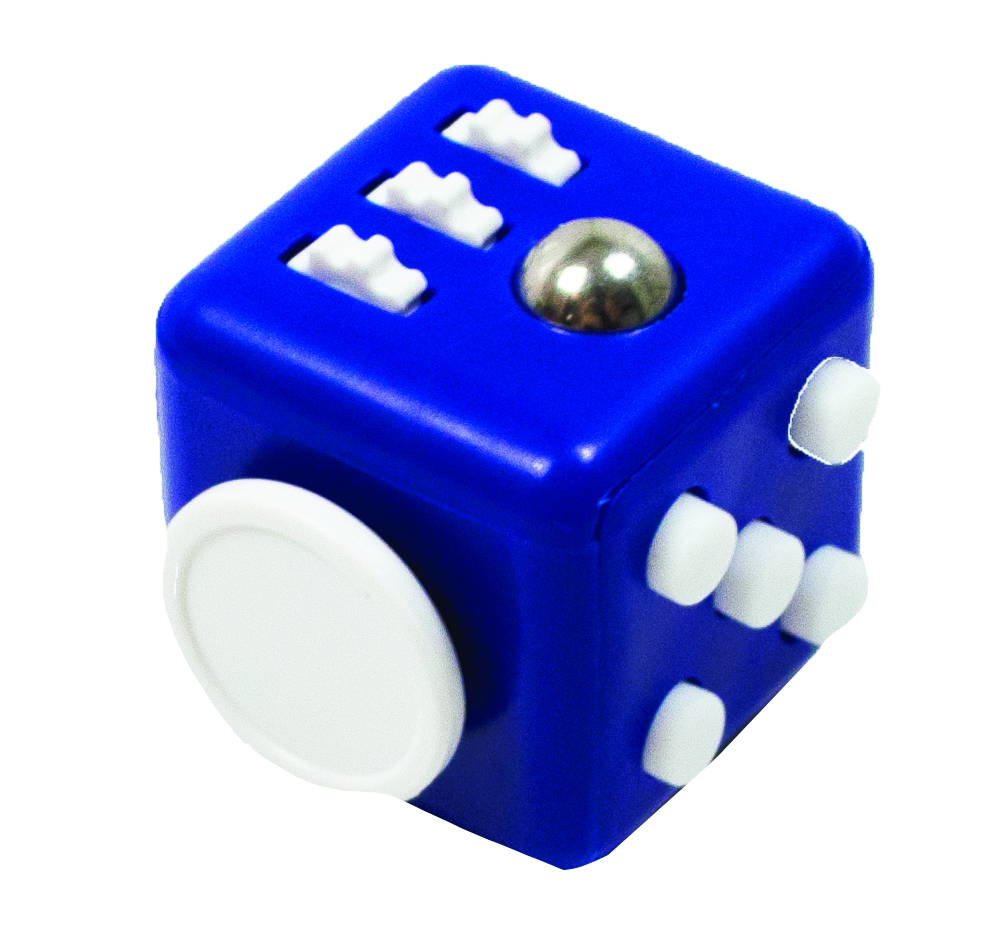Therapy Shoppe® is excited and pleased to welcome Carol Claflin, Ph.D. as a regular expert guest author! Dr. Claflin is a developmental psychologist, registered pediatric nurse, and former Associate Professional of Psychology before her retirement from teaching in 2007. She has conducted research in the field of ASD and chronic childhood illnesses, and has worked as a special needs educational consultant helping families and school districts develop individualized intervention programs and specialized in-service programming.
We all fidget! What kind of figeting do you like to do? Wiggle your leg, crack your knuckles, squirm in your seat, chew on your pencil, twirl your hair, fiddle with rubber bands, or do you prefer something else? Fidgeting helps us sharpen our focus – and can be especially helpful for children who have special needs, sensory processing differences, ADD, or ADHD.
Most fidget research has focused on children who have ADHD and has confirmed what many anecdotal reports have stated. Compared to typically-developing children, those who have ADHD fidget more. Research also shows that the more children with ADHD move, the more they increase their attention, number of accurate responses, and did better on memory tasks.[1,2,3] A recent study also documented more adaptive information processing.[4] It is hypothesized that hyperactivity in children with ADHD is a way to “unconsciously compensate for underarousal or underactivity in some brain regions.”[1, p. 2; 4]
In ADHD, there are low levels of some neurotransmitters in the brain, especially dopamine (DA) and norepinephrine (NE). Traditional ADHD medications work to increase the levels of these chemicals.[5,6] The good news is that physical activity, including fidgeting, can help to increase levels of dopamine and norepinephrine [4,7,8] and allow children who have ADHD to focus better, concentrate more, and improve cognitive performance. [7,9,10,11]
This is all great news! Using intentional fidgeting can enhance attention and academic performance in children with ADHD and in those with sensory processing difficulties.[9,10,11,12,13,14,15] According to Sydney Zentall, Ph.D., “An activity that uses a sense other than that required for the primary task – such as listening to music while reading a social studies textbook – can enhance (primary task) performance in children with ADHD.”[7, p.1] For example, when a child needs to look at and/or listen to the teacher, quiet tactile manipulatives or silent classroom fidgets can be effective classroom tool choices to help promote that increased focus.
 For children with sensory processing differences who need higher levels of sensory input; the more input they get, the better their concentration and attention becomes. Again, hands-on or feet-on fidgets are “very good regulators for attention and modulation in the environment and also help the brain to filter out distracting sensory input not related to the primary task."[16, p. 2] Similarly, reviews and studies of children with autism and adults with sensory processing issues consistently document that offering a sensory diet (that includes appropriate fidgets) helps improve sensory processing, and related emotions and behaviors.[17,18] Finally, tactile fidget tools in a “sensory box/suitcase” were found to be an effective component for helping teens who had behavioral and emotional problems understand how their senses influence how they calm themselves and work to control their impulses.[19]
For children with sensory processing differences who need higher levels of sensory input; the more input they get, the better their concentration and attention becomes. Again, hands-on or feet-on fidgets are “very good regulators for attention and modulation in the environment and also help the brain to filter out distracting sensory input not related to the primary task."[16, p. 2] Similarly, reviews and studies of children with autism and adults with sensory processing issues consistently document that offering a sensory diet (that includes appropriate fidgets) helps improve sensory processing, and related emotions and behaviors.[17,18] Finally, tactile fidget tools in a “sensory box/suitcase” were found to be an effective component for helping teens who had behavioral and emotional problems understand how their senses influence how they calm themselves and work to control their impulses.[19]

Effective types of fidget tools to address the types of issues listed above include: thinking putty, stress balls, squeezy or tactile fidget balls, kneadable erasers, fidgeting finger springs™ , finger squeezers, textured pencil grips, pencil topper fidgets, chewies, fidgeting foot bands™, foot fidget rollers, textured sensory rulers, chewy dog tags, chewable tubes necklaces, FiddleLinks, Showa Noas, velcro fidget strips, marble boinks, bendeez, tangles… the list goes on and on. Can’t decide which fidget tools would be best? Consider trying a Therapy Shoppe Fidget Kit™. There are even scented tools for those who gravitate towards using scented fidgets for calming, focusing, attaining, and maintaining that "just right" level of arousal. These could include fidgets like scented kneadable erasers, sensory squares, and even scented putty.
Fidgets can be successfully introduced into classrooms with some basic rules.[15] Before introducing fidget tools in your classroom, create some rules that are custom-tailored for your specific class and grade. Be sure to explain that fidgets are a learning tool and are not a toy. Perhaps use the analogy that some students need glasses to be able to function and focus better in the classroom; while other students need a fidget tool to help them pay attention better. It can also be helpful to model how to use specific fidgets. Include that if the rules are broken, you have the right to temporarily take away a fidget until the user can demonstrate that they can use it according to the rules. Potential rules might include:
• Fidget tools are to be used during listening activities and may only be used to help you focus and attend better, or to help your body feel calmer.
• Fidget tools are to be held in your hands and not tossed in the air, dropped, juggled, thrown, or bounced.
• Your fidget tools are for you only, and should not distract or interfere with your or other students' learning.
• When fidgets are not in use, they need to be kept out of sight (inside your desk) or in a designated space where they belong – such as a fidget box by the teacher's desk.
_______________________
The research confirms that fidgeting is helpful and can be an essential tool for many children who have sensory processing and/or autism spectrum disorders, ADD, or ADHD. What an "easy" tool to enhance the focus, concentration, and cognitive performance of individuals who are challenged in these areas! It is hoped that this research summary will be used to help educate those who might perceive fidgets as just being "toys" – or for those who don't realize that fidgeting can actually facilitate changes in brain chemicals. We all fidget – research supports that it can be a very beneficial activity for children who have unique needs that sometimes go hand-in-hand with disabilities.
– Dr. Carol Claflin, March 12, 2017
References
- Schweitzer, J., Lewis, S., & Hartanto, T. (2016, February). Don’t stop the movement. Retrieved from http://chadd.org/Membership/Attention-Magazine-Article.aspx?id=672
- Cloud, J. (2009, March). Kids with ADHD may learn better by fidgeting. Retrieved from http://content.time.com/time/magazine/article/0,9171,1889178,00.html
- Sarver, D., Rapport, M., Kofler, M., Raiker, M., & Friedman, L. (2015). Hyperactivity in attention-deficit/hyperactivity disorder (ADHD): Impairing deficit or compensatory behavior? Journal of Abnormal Psychology, 43(7), 1219-1232. doi:1007/s10802-015-0011-1
- Hartanto, T., Krafft, C., Iosif, A., & Schweitzer, J. (2016). A trial-by-trial analysis reveals more intense physical activity is associated with better cognitive control performance in attention-deficit/hyperactivity disorder. Child Neuropsychology, 22(5), 618-26. doi:10.1080/09297049.2015.1044511
- Hunt, R. (2006, March). Functional roles of norepinephrine and dopamine in ADHD. Retrieved from https://www.medscape.org/viewarticle/523887
- Badgaiyan, R. (2014) Imaging dopamine neurotransmission in live human brain. Progress in Brain Research, 211, 165-182. doi:10.1016/B978-0-444-63425-2.00007-6
- Rotz, R. & Wright, S. (n.d.). The body-brain connection: How fidgeting sharpens focus. Retrieved February 12, 2018 from https://www.additudemag.com/focus-factors
- Matlen, T. (n.d.). Dr. John Ratey discusses exercise and ADHD in new book. Retrieved February 11, 2018 from https://www.healthcentral.com/article/dr-john-ratey-discusses-exercise-and-adhd-in-new-book
- Ratey, J. (2013). ADHD: Running from distraction. In Spark: The revolutionary new science of exercise and the brain (pp. 141-166). New York, NY: Little, Brown, & Co.
- Donaldson James, S. (2015, June). Keep fidgeting! Movement helps improve focus in kids with ADHD. Retrieved from https://www.nbcnews.com/health/kids-health/fidgeting-movement-helps-improve-focus-kids-adhd-n373406
- Kamenetz, A. (2015, May). Vindication for fidgeters: Movement may help students with ADHD concentrate. Retrieved from https://www.npr.org/sections/ed/2015/05/14/404959284/ fidgeting-may-help-concentration-for-students-with-adhd
- Friendship Circle/Fidgets: What are they and how can they help? (2011, October). Retrieved from http://www.friendshipcircle.org/blog/2011/10/31/fidgets-what-are-they-and-how-can-they-help
- Isbister, K. (2017, May). Fidget toys aren’t just hype. Scientific American: The conversation. Retrieved from https://www.scientificamerican.com/article/fidget-toys-arent-just-hype
- Spiegel, E. (2017, March). Managing stress for at-risk students: a Massachusetts school that specializes in educating highly stressed adolescents offers lessons that could benefit all classrooms. Phi Delta Kappa International, 98(6), 42-46. org/10.1177/0031721717696477
- Silver, E. (2017, May 9). Fidget toys: Effective tools or classroom distractions? The Washington Post. Retrieved from http://www.ajc.com/lifestyles/fidget-toys-effective-tools-classroom-distractions/i4FB0QtMsMA6e9L0YY8zrN
- Mennillo, M. (2017, March). Stop touching things! The role of fidget toys. Retrieved from http://occupationaltherapychildren.com.au/stop-touching-things-the-role-of-fidget-toys
- Scharf, R., Durmont, R., & May-Benson, T. (2017). Efficacy of occupational therapy using Ayres Sensory Integration®: A systematic review. American Journal of Occupational Therapy, 72, doi:10.5014/ajot.2018.028431
- American Occupational Therapy Association. (n.d.). Fact sheet: Occupational therapy using a sensory integration-based approach with adult populations. Retrieved February 12, 2018 from https://www.aota.org/About-Occupational-Therapy/Professionals/HW/Using-Sensory-Integration-Based-Approach-With-Adult-Populations.aspx
- Dorman, C., Nowotny Lehsten, L., Woodin, M., Cohen, R., Schweitzer, J., & Trigilio Tona, J. (2009, May). Using sensory tools for teens with behavioral and emotional problems. Retrieved from http://www.ateachabout.com/pdf/OTP_Nov09_UsingSensoryTools_Teens.pdf
©2018 Therapy Shoppe® Incorporated. All rights reserved.
More articles you might enjoy:
23 Favorite Stress Reducing Fidget Tools
21 Favorite Tools for Compulsive Skin Pickers (Dermatillomania)
Fidget Tools: Not Just for Kids
23 Sensory Fidget Toys for ADD and ADHD

